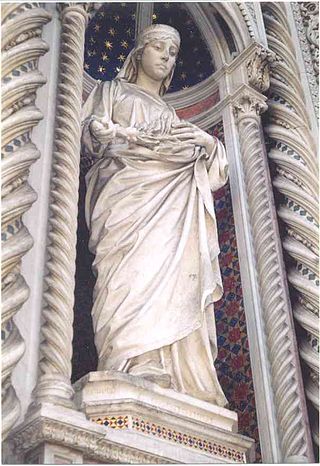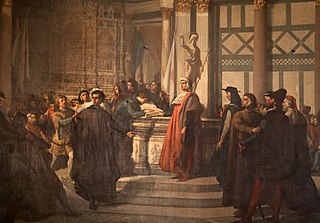
Dante Alighieri, most likely baptized Durante di Alighiero degli Alighieri and often referred to as Dante, was an Italian poet, writer and philosopher. His Divine Comedy, originally called Comedìa and later christened Divina by Giovanni Boccaccio, is widely considered one of the most important poems of the Middle Ages and the greatest literary work in the Italian language.

Florence is the capital city of the region of Tuscany in Central Italy. It is also the most populated city in Tuscany, with 360,930 inhabitants in 2023, and 984,991 in its metropolitan area.

The Republic of Florence, known officially as the Florentine Republic, was a medieval and early modern state that was centered on the Italian city of Florence in Tuscany, Italy. The republic originated in 1115, when the Florentine people rebelled against the Margraviate of Tuscany upon the death of Matilda of Tuscany, who controlled vast territories that included Florence. The Florentines formed a commune in her successors' place. The republic was ruled by a council known as the Signoria of Florence. The signoria was chosen by the gonfaloniere, who was elected every two months by Florentine guild members.
This article deals with the history of Tuscany.

Giovanni Villani was an Italian banker, official, diplomat and chronicler from Florence who wrote the Nuova Cronica on the history of Florence. He was a leading statesman of Florence but later gained an unsavoury reputation and served time in prison as a result of the bankruptcy of a trading and banking company he worked for. His interest in and elaboration of economic details, statistical information, and political and psychological insight mark him as a more modern chronicler of late medieval Europe. His Cronica is viewed as the first introduction of statistics as a positive element in history. However, historian Kenneth R. Bartlett notes that, in contrast to his Renaissance-era successors, "his reliance on such elements as divine providence links Villani closely with the medieval vernacular chronicle tradition." In recurring themes made implicit through significant events described in his Cronica, Villani also emphasized three assumptions about the relationship of sin and morality to historical events, these being that excess brings disaster, that forces of right and wrong are in constant struggle, and that events are directly influenced by the will of God.

Domenico di Michelino (1417–1491) was an Italian Renaissance painter who was born and died in Florence. His real name was Domenico di Francesco. The patronymic "di Michelino" was adopted in honour of his teacher, the cassone painter Michelino di Benedetto, by whom no works have been identified. Giorgio Vasari reports that Domenico was also a pupil of Fra Angelico, whose influence is reflected in many of Domenico's paintings along with that of Filippo Lippi and Pesellino.
The Ciompi Revolt was a rebellion among unrepresented labourers which occurred in the Republic of Florence, from 1378 to 1382. Those who revolted consisted of artisans, labourers, and craftsmen who did not belong to any guilds and were therefore unable to participate in the Florentine government. These labourers had grown increasingly resentful over the established patrician oligarchy. In addition, they were expected to pay heavy taxes which they could not afford, forcing some to abandon their homes. The resulting insurrection over such tensions led to the creation of a government composed of wool workers and other disenfranchised workers which lasted for three and a half years.

Guido Cavalcanti was an Italian poet. He was also a friend and intellectual influence on Dante Alighieri.

The Republic of Lucca was a medieval and early modern state that was centered on the Italian city of Lucca in Tuscany, which lasted from 1160 to 1805.

Manente degli Uberti, known as Farinata degli Uberti, was an Italian aristocrat and military leader of the Ghibelline faction in Florence. He was considered to be a heretic by some of his contemporaries, including Dante Alighieri, who mentioned Farinata in his Inferno.

Florence weathered the decline of the Western Roman Empire to emerge as a financial hub of Europe, home to several banks including that of the politically powerful Medici family. The city's wealth supported the development of art during the Italian Renaissance, and tourism attracted by its rich history continues today.

Dino Compagni was an Italian historical writer and political figure.

The Simonetti family is an Italian noble family with origins in Tuscany. During the 12th century different branches in Florence, Terni, Lucca, Pistoia and Pescia developed. Other famous branches of this family were established in Jesi, Palermo, Milan and Bologna.

Corso Donati was a politician and leader of the Black Guelph faction in 13th- and early 14th- century Florence.
Gualdrada Berti dei Ravignani was a member of the Ghibelline nobility of twelfth-century Florence, Italy. A descendant of the Ravignani family and daughter of the powerful Bellincione Berti, Gualdrada later married into the Conti Guido family. Her character as a pure and virtuous Florentine woman is called upon by many late medieval Italian authors, including Dante Alighieri, Giovanni Boccaccio, and Giovanni Villani.

The Nuova Cronica or New Chronicles is a 14th-century history of Florence created in a year-by-year linear format and written by the Italian banker and official Giovanni Villani. The idea came to him after attending the first Jubilee in the city of Rome, in 1300, where he realized that Rome's many historical achievements were well-known, and he desired to lay out a history of the origins of his own city of Florence. In his Cronica, Villani described in detail the many building projects of the city, statistical information on population, ordinances, commerce and trade, education, and religious facilities. He also described several disasters such as famines, floods, fires, and the pandemic of the Black Death in 1348, which would take his own life. Villani's work on the Nuova Cronica was continued by his brother Matteo and his nephew Filippo after his death. It has been described as the first introduction of statistics as a positive element in history.

Gonfaloniere of Justice was a post in the government of medieval and early Renaissance Florence. Like Florence's Priori, it was introduced in 1293 when Giano Della Bella's Ordinances of Justice came into force.
The Torre dei Della Bella is an old tower of Florence, Italy and is located in Via dei Tavolini.

Cianghella della Tosa lived in late medieval Florence, Italy. She was born into the Florentine Della Tosa family and married into the Alidosi family of Imola, near Bologna. Most of what is known about Cianghella is due to her reference in Dante's Divine Comedy.
Della Bella is an Italian surname. Notable people with this name include the following:















